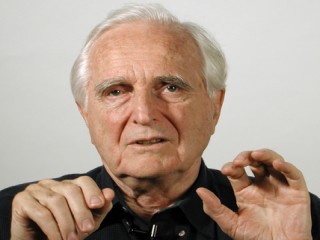
Doug Engelbart biography
Date of birth : 1925-01-30
Date of death : -
Birthplace : Portland, Oregon, United States
Nationality : American
Category : Science and Technology
Last modified : 2011-09-30
Credited as : computer pioneer, inventor, computer mouse
1 votes so far
Engelbart was born in the U.S. state of Oregon on January 30, 1925 to Carl Louis Engelbart and Gladys Charlotte Amelia Munson Engelbart. He is of German, Swedish and Norwegian descent.
He was the middle of three children, with a sister Dorianne (3 years older), and a brother David (14 months younger). They lived in Portland in his early years, and moved to the countryside to a place called Johnson Creek when he was 9 or 10, after the death of his father. He graduated from Portland's Franklin High School in 1942. Midway through his college studies at Oregon State University (then called Oregon State College), just at the end of World War II, he was drafted into the Navy, serving two years as a radar technician in the Philippines. It was there on a small island in a tiny hut up on stilts that he first read Vannevar Bush's article "As We May Think", which greatly inspired him. He returned to Oregon State and completed his Bachelor's degree in Electrical Engineering in 1948, a B.Eng. from UC Berkeley in 1952, and a Ph.D. in EECS from UC Berkeley in 1955. While at Oregon State, he was a member of Sigma Phi Epsilon social fraternity. As a graduate student at Berkeley he assisted in the construction of the California Digital Computer project CALDIC. His graduate work led to several patents[6]. After completing his PhD he stayed on at Berkeley to teach for a year, and left when it was clear he could not pursue his vision there. He then formed a startup, Digital Techniques, to commercialize some of his doctorate research on storage devices, but after a year decided instead to find a venue where he could pursue the research he had been dreaming of since 1951.
Because Engelbart's research and tool-development for online collaboration and interactive human-computer interfaces was partially funded by ARPA, SRI's ARC became involved with the ARPANET (the precursor of the Internet). On October 29, 1969, the world's first electronic computer network, the ARPANET, was established between nodes at Leonard Kleinrock's lab at UCLA and Engelbart's lab at SRI. Interface Message Processors at both sites served as the backbone of the first Internet.
Engelbart's computer lab at SRI was the second link on ARPANET, the precursor to the internet, and received the first message sent between two nodes. The message, sent from the SDS Sigma 7 computer at UCLA to SRI's SDS 940 computer, was supposed to consist of the word "log", followed by Engelbart's reply of "in", thus spelling the word "log-in". The computer at UCLA crashed after sending only two characters - "lo" - but those letters were instantaneously received at 10:30 PM local time on 29 October 1969 at Engelbart's SRI laboratory, making it arguably the birthplace of the internet. Engelbart also holds numerous patents relating to digital devices and magnetic memory. His father was a first cousin of Nobel laureate Bjørnstjerne Bjørnson. Engelbart was diagnosed with Alzheimer's disease in 2007.
















